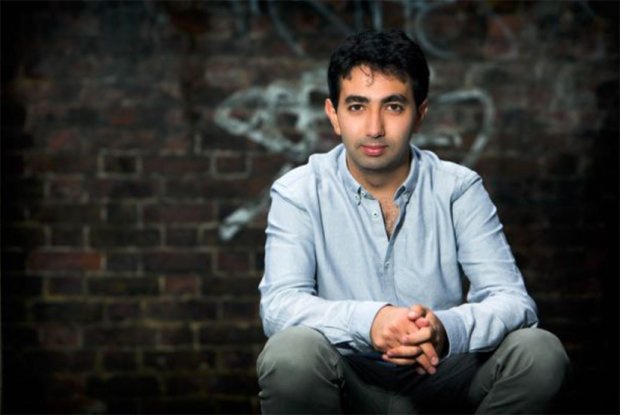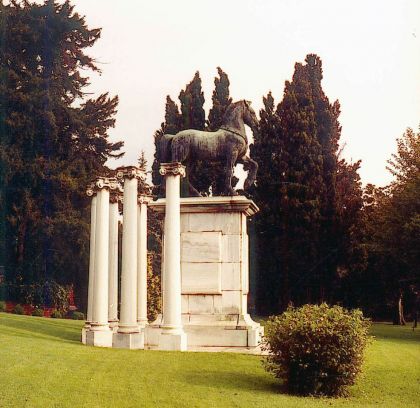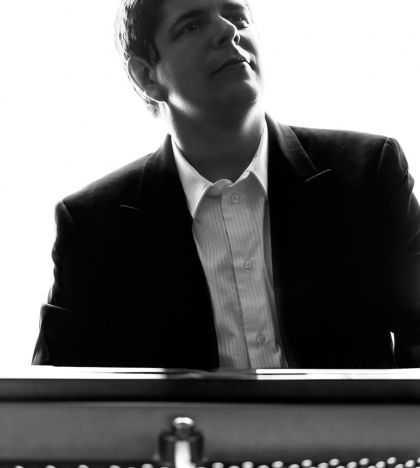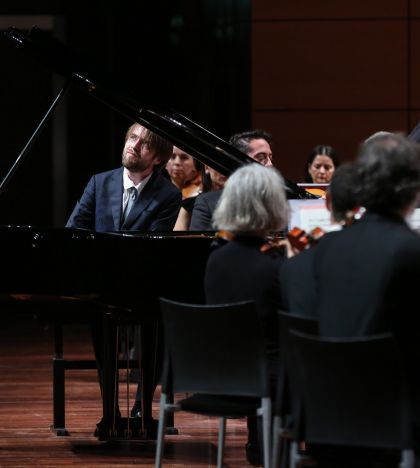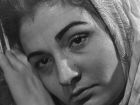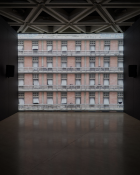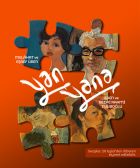The piano recital by Karim Said at the Sakıp Sabancı Museum (‘The Seed’) in Emirgan, Istanbul, on Tuesday June 12 was preceded by a talk in which the performer described the rationale behind his choice of the works in what was, to be truthful, an extremely unusual programme.
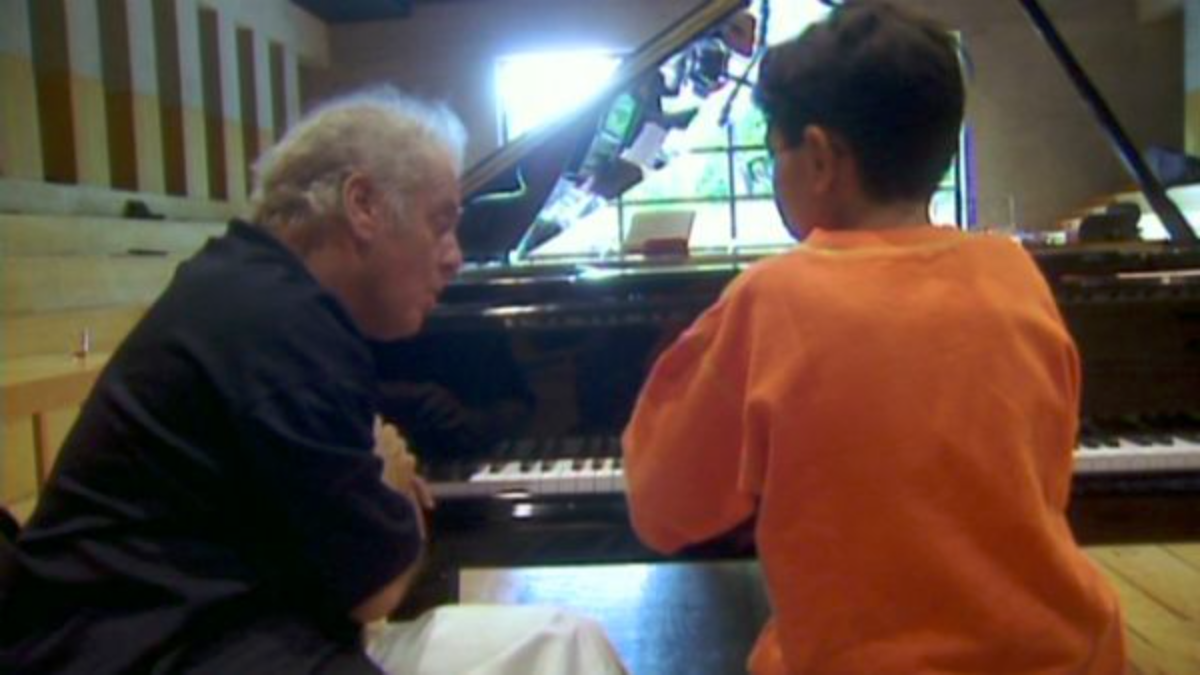
Born into a Palestinain family in Jordan, Karim Said came to public attention as a child prodigy in 1999 after being ‘discovered’ by Daniel Barenboim at the age of ten (pictured above, see karimsaid.com). He received his first piano lessons from Agnes Bashir-Dzodtsoeva in his native Amman, subsequently completing his musical training at the Purcell School of Music in Hertfordshire and the Royal Academy of Music in London – where his teacher was Tatiana Sarkissova, a distinguished exponent of the Moscow school of piano playing. (As a result of the years he has spent in the UK, his English is fluent. He is also very articulate, unsurprisingly considering that his grandfather was a cousin of the author Edward Said, controversial author of Orientalism (1978) and founder, with Barenboim, of the West-Eastern Divan Orchestra.) More recently, he has been coached by Hinrich Alpers in Berlin, a pianist well known for his interpretations of Beethoven and his championing of less popular genres such as early music and the works of the composers of the Second Viennese School. It is perhaps no coincidence that all three of the aforementioned areas were featured in Karim Said’s programme.
Before sitting down at the piano, he explained the reasons behind his choice of the works we were to hear. They had been selected, he told us, to showcase two main themes: that of variations, and that of the teacher-pupil relationship. Two of the items were to consist of variations – in the form of ‘grounds’, or tunes repeated several times with a different form of ornamentation each time – from the early British composers William Byrd and Thomas Tomkins. In addition there were to be sets of variations from Brahms and Beethoven that were more modern in nature (ie, more adventurous in terms of their treatment of the theme). The subject of the teacher-pupil relationship, meanwhile, was to be highlighted by means of works by Arnold Schoenberg and his pupil Anton von Webern, composers of the early-20th-century Second Viennese School, as well as pieces by Brahms and his idol Beethoven.
An anecdote is called for here. Brahms, in addition to being an extreme Beethoven freak, was also famously modest about his own abilities – and, in addition, an enthusiastic consumer of alcohol (to put it nicely): the Cockney rhyming-slang expression ‘Brahms and Liszt’ is not at all inappropriate in his case. During a dinner at the house of a wine connoisseur, the host brought out what he thought to be his best bottle of wine. Pouring some of the much-prized liquid into Brahms’s glass, he announced: 'This is the Brahms of my cellar.' Brahms carefully examined the wine, inhaled its bouquet and held it to the light. After a long pause (being a Taurus, he did not like to be hurried), he took a sip and set the glass down on the table. Eager to know what his guest thought of the wine, the host asked: 'How do you like it?' Brahms replied: 'You’d better bring out your Beethoven.'
Continuing his talk, Mr Said asked for the audience's indulgence towards the music of Schoenberg and Webern, and to take account of the fact that their aesthetic was of a different kind from the one commonly regarded as ‘normal’. It was noticeable that there were a good number of empty seats in the auditorium, the reason for which may well have been the fact that quite a lot of people would prefer a visit to the dentist for a root extraction rather than sit through a performance of Schoenberg. Although I performed his Six Little Piano Pieces several times while at Cambridge, I have to say that a good deal of what Schoenberg wrote after abandoning his more conventional style (exemplified by his string sextet Verklärte Nacht, ‘Transfigured Night’, written in 1899) sounds just ugly to me. I know he invented a new method of composition that changed the course of the 20th century, but the music itself is often ‘challenging’. There are exceptions, however, and more of this anon.
So in order to push the reader gently in the direction of the shark-infested swimming pool – or more likely the room in the spaceship where the monster hangs out in the film Alien – I have chosen to pacify you with an example of Schoenberg’s earlier, more approachable style before we get down to the heavy-duty stuff. Here is a YouTube video of his late-Romantic, fin-de-siècle Verklärte Nacht:
Once he had turned in the direction of atonality and invented 12-tone music (more of this later), Schoenberg started playing with musical form in a way never done before: for instance, in ‘Der Mondfleck’ (‘The Moonspot’, the 18th piece in his song cycle Pierrot Lunaire, composed in 1912), when the words ‘einen weissen Fleck’ – ‘a white spot’ – are uttered, all the notes that have occurred in the music so far are repeated in reverse order, creating a mirror effect. If we were to take the letters in the words ‘a mirror effect’ as an example, the result of applying this technique would be as follows:
a m i r r o r e f f e c t t c e f f e r o r r i m a
Another thing you will notice in the video that follows is that the singer is using Sprechstimme, a kind of half-sung speech. Look out for ‘einen weissen Fleck’ at 0:26, in bar 10:
To say that Schoenberg’s efforts to ‘emancipate the dissonance’ did not meet with universal approval would be an understatement: members of the audience frequently walked out during performances of the works he produced after he entered his atonal period in 1908. You may or not agree with the critic James Hunecker, who wrote the following review after listening to the first performance of Pierrot Lunaire:
The very ecstasy of the hideous!… Schoenberg is… the cruellest of all composers, for he mingles with his music sharp daggers at white heat, with which he pares away tiny slices of his victim’s flesh. Anon he twists the knife in the fresh wound and you receive another thrill… There is no melodic or harmonic line, only a series of points, dots, dashes or phrases that sob and scream, despair, explode, exalt and blaspheme.
But enough of the woo-woo stuff: it is time to get back to the concert. The programme began with a performance of Qui Passe by William Byrd (1540–1623), which is a set of ‘grounds’ (ie, variations) on an Italian theme. Karim Said’s expressive body language was immediately noticeable: in this piece there was a good deal of head- and hair-shaking. Although his style was in general controlled, he adopted an agreeably jaunty manner where the rhythm permitted. This performance of Qui Passe by Timothy Roberts on the virginals (the late-Renaissance proto-harpsichord for which the work was written) is accompanied by some excellent notes – available on YouTube:
Brahms’s thick, heavy bass is very much in evidence throughout most of the piece: Taurus people tend to like solid, copper-bottomed chords. There is, however, an absolutely charming tinkly bit (in the above recording, this starts at 07:17). Karim Said was well aware of these contrasts, and gave us a perfect rendering of both the stomping bass and the tinkles, which sounded nice and bell-like in the upper register of the Steinway he was playing. His pedalling was restrained, and wisely so: it would be all too easy to let the dense accompanying parts drown out the melody. One of this pianist’s outstanding features is the excellence of his phrasing (no doubt this is what Daniel Barenboim picked up on), and the way he began all his phrases with aplomb and ended them with perfect appropriacy was a delight.
The second half of the programme began with another example of early music: the Pavan and Galliard: Lord Strafford, a piece by the little-known composer and organist Thomas Tomkins (1572–1656). Tomkins, a Pembrokeshire man by birth and a pupil of Byrd, was organist of Worcester Cathedral from 1585 to 1646; in 1621 he was appointed to the prestigious post of organist to the Chapel Royal, and this brought him into contact with other fine composers of his time such as Orlando Gibbons. His compositions include madrigals, keyboard music and consort music for viols as well as church anthems and services.
The choice of Worcester as a place of residence did not prove to be an entirely prudent one as the city was besieged by the Parliamentarians in 1642, during the Civil War, and the fine new organ Tomkins had had installed in the cathedral was damaged when this edifice was vandalised by Puritan soldiers who took great pleasure in destroying every sign of what they regarded as ‘popery’. They are said to have put on the surplices they found in the vestry and ridden around the city wearing them. But their rampage had its price: the first man who went for the organ with an axe fell off the stepladder he was standing on, and broke his neck.
It was during the first siege of Worcester, too, that Tomkins’s house on College Green was partially destroyed. The poor man may have thought this was all he would have to endure, but he was wrong: the Roundheads came back for another bash in 1646. Tomkins, a devoted Royalist, wrote the music for the coronation of Charles I, and his Sad Paven for these Distracted Tymes was composed not long after Charles’s execution in 1649. However, neither these pieces nor his Pavan and Galliard: Lord Strafford (1647), written in memory of the Earl of Strafford (the order for whose execution was signed by King Charles under duress), seem to have landed him in any serious bother. Not only this, but the fact that his son was – or is at least rumoured to have been – an agent of Archbishop Laud, who lost his head in 1645, likewise passed unnoticed. Indeed, the Church Times website describes Tomkins as ‘one of music’s great survivors’.
Karim Said’s performance of the Pavan and Galliard: Lord Strafford was notable for the delicacy with which he played the middle parts in the Pavan, and for the well-managed changes of rhythm in the highly-ornamented Galliard that followed. Galliards were much more energetic dances than pavanes (a word that is sometimes spelt ‘pavans’): a pavane was a slow, stately processional dance favoured by the European aristocracy in the 16th and 17th centuries (frankly, its purpose was to allow the performers to show off their costumes), while the galliard involved leaping into the air – thus providing an opportunity for the gentlemen to demonstrate their athletic prowess to their partners. Here is a performance of Tomkins’s piece on a rather more old-fashioned instrument than the pianoforte:
(Warning: readers who are not interested in the mechanics of the music of Schoenberg and Webern should skip this paragraph.) In 12-tone music, the 12 semitones that make up an octave are played in a fixed order, each of the notes being played only once, and this sequence is then repeated over and over. For instance, the set of notes – or ‘tone row’ – used by Schoenberg in his Wind Quintet (1924) is E♭–G–A–B–C♯–C–B♭–D–E–F♯–A♭–F; the tone row for his String Quartet No 4 (1936) is D–C♯–A–B♭–F–E♭–E–C–A♭–G–F♯–B. There are additional possibilities in that the notes in the tone row can be played in various permutations: for instance, the sequence can be played in reverse order – that is, back to front – or it can be inverted (ie, in the second of the two tone rows given above, instead of playing D and then going down to C sharp, you play D and then go up the same distance – in this case a semitone – to D sharp; after that, you go on inverting all the remaining intervals in the same way). And then, of course, there is the inverted version of the backwards ordering. Twelve-tone music does not sound repetitive as two or more of the notes in the tone row can be played simultaneously in a chord: the fact that different notes can be played together each time the sequence is repeated creates constant variation. (Phew! That was complicated.)
Here is a performance of the Kinderstück with the score:
Webern had a huge influence on a number of 20th-century composers, including Stravinsky, Messiaen, Boulez and Stockhausen. As an example of this influence, here is Baryshevskyi once again in a performance of the Klavierstück No 5 by Karlheinz Stockhausen (1928-2007):
Anton von Webern’s life did not end on a happy note, though he had started out with an advantage: his father, a mining engineer, rose to become Chief of Mining in the Habsburg government of Austria-Hungary. I cannot help wondering if in the course of his duties this man ever visited the coal-mining town of Anina, in Banat (a province of south-west Romania). I am a fan of Romanian railways, especially the ones that have steam engines (which they call Mocanita), and cannot resist sharing with you this film of a trip along the incredibly beautiful line from Oravita to Anina, built by Austrian engineers in the mid-19th century:
In 1945 Webern’s only son, Peter, was killed in a strafing raid on a train. When the Russian Army neared Vienna, the composer and his wife fled to Mittersill, near Salzburg, where their three daughters and grandchildren had sought refuge. It was there that Webern himself met his end: the story I have heard is that on September 15, while visiting the house of one of his daughters, he went to the kitchen to get himself some coffee. Meanwhile, an American soldier of the forces of occupation had entered the house unannounced via a back entrance; seeing Webern as a dark shape in the unlit corridor leading from the front of the house to the kitchen, he shot him.
Webern is one of my cultural icons. I think his music is vastly more exciting than that of Schoenberg: the ‘pointillisme’ creates a fascinatingly dense texture that is at the same time rhythmically driven and dramatic, and the extreme brevity of his pieces gives them a tense, fragile quality that challenges one to live in the moment – thus rendering them ‘modern’ in the best sense of the word. Nice one, Anton.
Mr Said managed the jumps and hand-crossings in the Kinderstück and Klavierstück very well. The extreme contrasts in the dynamics were well brought out, though I could have done with a little more delicacy at times: the tendency to make the music sound harsh can, with care, be avoided.
The recital ended with a performance of Beethoven’s Variations and Fugue in E flat major, often referred to as the ‘Eroica Variations’ as they are based on the central theme in the final movement of his Third Symphony, the Eroica. The composer was going deaf at the time when the piece was written (though he refused to acknowledge this fact), and the pounding chords may be the result of his desire to be able to hear something of what he was playing: they certainly tire the pianist’s hands. The performer’s sense of timing, especially at the beginning and end of each variation, was impeccable, though his technique became a little shaky under the strain and there were quite a few splashes. If I were him, I would concentrate on improving the evenness of my playing in rapid passages, especially scales. Artur Schnabel might be an appropriate role model in this respect.
After that somewhat ungenerous comment, I must add that although this piece is one Karim Said seems to perform frequently, he showed no sign of staleness at the concert in Emirgan. Here is a YouTube video of him playing it at the Guildhall School of Music in 2015:
Returning for a second time to reward us for our appreciation, he played a work of his own making. Here, I feel obliged to say – with the utmost respect – that not all concert pianists make good composers. I might even be so bold as to tiptoe up to Fazıl Say, and whisper into his ear – again with the utmost respect – that he might do well to be just a tiny bit more self-critical in this regard. There, it is over. I hope no offence is taken.
Anyone who can dedicate a piece of music to a female poet from Ancient Iraq said to have had an influence on the literary style of the Psalms has my respect. Karim Said’s composition was dedicated to just such a woman – Enheduanna, who apparently lived from 2285 to 2250 BC and was the daughter of Sargon of Akkad; she was also High Priestess of the most important temple in Sumer. Awesome chick, huh? Fuller information about this remarkable lady is available here: https://www.ancient.eu/Enheduanna/
Before the concert, Nazan Ceylan (general coordinator of the Istanbul Recitals), who had most thoughtfully provided me, once more, with a seat from which I had a perfect view of the pianist’s hands, told me of her admiration for the piece, and I have to say I was wowed by it, too: Karim Said has obviously come a long way in terms of his maturity as a composer. The Schoenberg-like first chord created an enticing prelude to the subtle glissandos and translucent, glassy chords (reminiscent of Messiaen) that followed. A real treat.
Full marks to Karim Said for bringing the music of Webern – and yes, that of Schoenberg too – to Istanbul. The inclusion of early music (in particular the Thomas Tomkins piece, which was quite a revelation) in the programme was another plus. And as for his own compositions, I would like to hear more of them. A most successful evening, I thought. Daniel Barenboim wasn’t far wrong.

